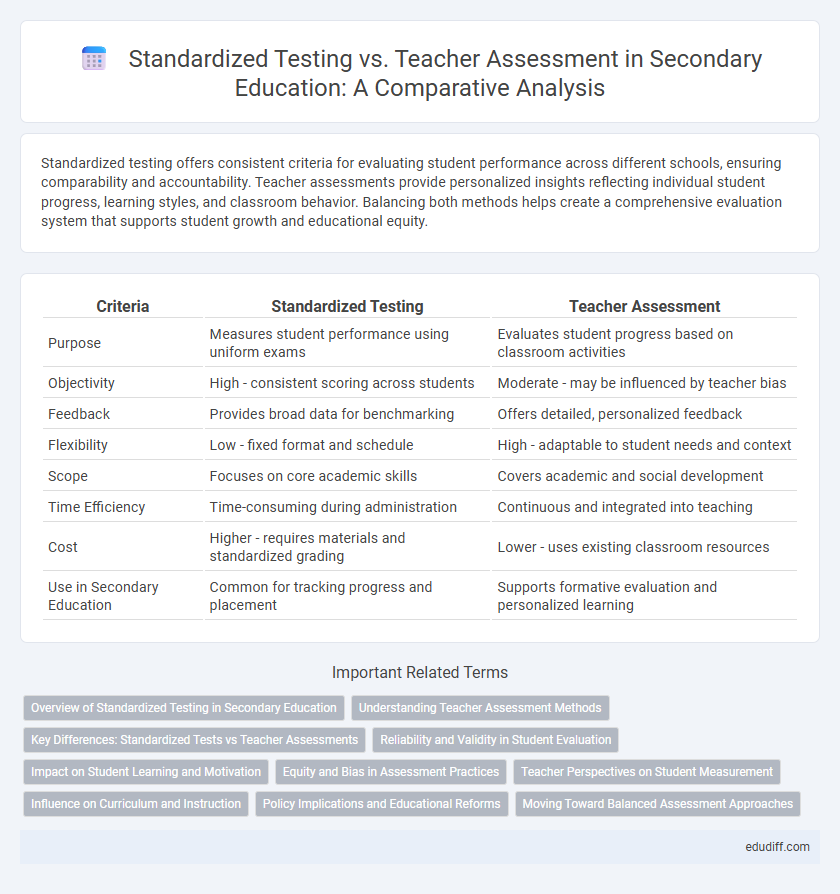Standardized testing offers consistent criteria for evaluating student performance across different schools, ensuring comparability and accountability. Teacher assessments provide personalized insights reflecting individual student progress, learning styles, and classroom behavior. Balancing both methods helps create a comprehensive evaluation system that supports student growth and educational equity.
Table of Comparison
| Criteria | Standardized Testing | Teacher Assessment |
|---|---|---|
| Purpose | Measures student performance using uniform exams | Evaluates student progress based on classroom activities |
| Objectivity | High - consistent scoring across students | Moderate - may be influenced by teacher bias |
| Feedback | Provides broad data for benchmarking | Offers detailed, personalized feedback |
| Flexibility | Low - fixed format and schedule | High - adaptable to student needs and context |
| Scope | Focuses on core academic skills | Covers academic and social development |
| Time Efficiency | Time-consuming during administration | Continuous and integrated into teaching |
| Cost | Higher - requires materials and standardized grading | Lower - uses existing classroom resources |
| Use in Secondary Education | Common for tracking progress and placement | Supports formative evaluation and personalized learning |
Overview of Standardized Testing in Secondary Education
Standardized testing in secondary education measures student performance using uniform exams designed to evaluate knowledge across core subjects like math, science, and language arts. These tests provide quantifiable data that schools and districts use to compare academic achievement and inform policy decisions. Critics argue standardized tests may not fully capture student learning or critical thinking skills, emphasizing the need for complementary assessment methods.
Understanding Teacher Assessment Methods
Teacher assessment methods in secondary education emphasize continuous observation, portfolio evaluations, and formative feedback to measure student progress more holistically than standardized testing. These methods capture individual learning styles, critical thinking, and problem-solving skills that standardized tests may overlook. Integrating diverse assessment techniques enhances personalized learning experiences and provides a comprehensive view of student achievement.
Key Differences: Standardized Tests vs Teacher Assessments
Standardized tests provide quantifiable data through uniform questions, enabling comparison across diverse student populations, while teacher assessments offer personalized evaluations reflecting individual student progress and context. Standardized tests emphasize objective scoring and broad curriculum coverage, whereas teacher assessments prioritize qualitative feedback and adaptability to students' unique learning styles. The primary difference lies in the rigidity and scale of standardized tests compared to the flexibility and nuance inherent in teacher assessments.
Reliability and Validity in Student Evaluation
Standardized testing offers high reliability through uniform administration and scoring, ensuring consistent results across diverse student populations. However, its validity is often questioned due to limited scope, as tests may not capture all aspects of student learning and critical thinking skills. Teacher assessments provide rich, valid insights into individual student progress but can suffer from lower reliability due to subjective evaluation and potential bias.
Impact on Student Learning and Motivation
Standardized testing often narrows curriculum focus, potentially hindering creative and critical thinking skills essential for deep learning. Teacher assessments provide a more personalized evaluation, fostering student motivation through tailored feedback and recognition of individual progress. Research indicates that balanced integration of both methods optimizes academic achievement and enhances student engagement in secondary education.
Equity and Bias in Assessment Practices
Standardized testing in secondary education often exhibits inherent biases that disproportionately affect marginalized student groups, including those from low-income backgrounds and English language learners. Teacher assessments, while more flexible and context-aware, can also introduce subjective biases related to racial or cultural stereotypes unless carefully standardized and regularly reviewed for equity. Implementing a balanced approach that combines objective data from standardized tests with nuanced insights from teacher assessments can promote fairness and mitigate inequities in academic evaluation.
Teacher Perspectives on Student Measurement
Teacher perspectives on student measurement emphasize the nuanced understanding gained through ongoing assessment rather than relying solely on standardized testing. Educators argue that teacher assessments provide a comprehensive evaluation of student progress by incorporating classroom behavior, participation, and individual learning styles. This holistic approach supports more personalized feedback and adaptive instruction, fostering better academic outcomes.
Influence on Curriculum and Instruction
Standardized testing imposes a rigid framework on curriculum design, often narrowing instructional focus to test preparation and limiting teacher creativity. In contrast, teacher assessment enables more adaptable and individualized instruction, aligning teaching strategies with student needs and fostering deeper understanding. This influence shapes the balance between breadth and depth in secondary education curricula.
Policy Implications and Educational Reforms
Standardized testing policies often drive educational reforms aimed at accountability and measurable outcomes, influencing curriculum alignment and resource allocation at the secondary school level. Teacher assessments emphasize formative evaluation, promoting personalized instruction and holistic student development, which calls for policy shifts toward professional development and flexible evaluation frameworks. Balancing these approaches requires reforms that integrate data-driven decisions from standardized tests with the nuanced insights of teacher assessments to enhance educational equity and effectiveness.
Moving Toward Balanced Assessment Approaches
Balanced assessment approaches in secondary education integrate standardized testing with teacher assessments to provide a comprehensive evaluation of student learning. Combining quantitative data from standardized tests with qualitative insights from teacher observations helps identify individual strengths and areas for improvement. This blended strategy supports personalized instruction, promotes equity, and enhances overall educational outcomes.
Standardized Testing vs Teacher Assessment Infographic

 edudiff.com
edudiff.com